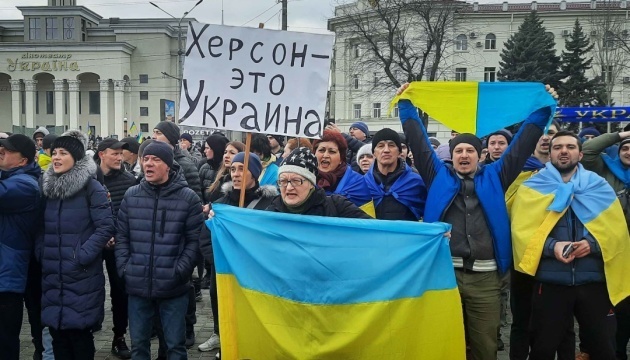
Russian ‘Referendums’ Delayed, Ukrainian Resistance Mounting in Occupied Kherson and Zaporyzhzhia (Part Two)
Publication: Eurasia Daily Monitor Volume: 19 Issue: 132
By:

Armed resistance within the occupied territory, coupled with Ukrainian army counterattacks along the front lines, have compelled Moscow to postpone the “referendums” for annexing Ukraine’s Kherson and Zaporyzhzhia regions to Russia (see EDM, September 8).
Ukrainian armed resistance has grown in intensity in recent months. It has manifested itself, thus far, mainly in targeting local collaborators for assassination. Such actions thus far are sporadic, anonymous and lacking any signs of organization. They rarely target the Russian military or Russian civilian carpetbaggers. Rather, actions target local collaborators who are working for the Russian-installed military-civil administrations. Whether these actions are purely local in origin or assisted by the Ukrainian intelligence services is unknown.
On March 20, Kherson city council member Pavel Slobodchikov was killed in his car by two gunmen who were seen fleeing (T.me/Kazansky, March 20; Most.ks.ua, March 20). Slobodchikov had been a close associate of Vladimir Saldo, leader of the eponymous party (now banned in Ukraine) and designated head of the Russian-installed military-civil administration of Kherson region (see below).
On April 20, occupation-supporting blogger Valery Kuleshov was assassinated in his car by gunmen outside his dwelling in Kherson city. Kuleshov had been a close associate of Kirill Stremousov, the designated deputy head of the military-civil administration of this region (Most.ks.ua, April 20).
On May 22, the Russian-installed mayor of Enerhodar (site of the Zaporyzhzhia nuclear power plant), Andrei Shevchik, was injured by a bomb blast outside his home (TASS; RIA Novosti, May 22).
On June 18, senior police official Yevgeny Sobolev, the Russian-appointed head of Kherson region’s prisons, was wounded in his car by a bomb blast (RIA Novosti, June 18).
On June 22, the Russian-installed mayor of Chornobayivka (Kherson region), Yuri Turulev, was wounded on his way to work by an explosive attached to his car (RIA Novosti, June 22).
On June 24, Dmitry Savluchenko, organizer of the “Novaya Rossiya” youth movement in Kherson region and head of the youth policy department in the Russian military-civil administration, was assassinated in his car by a bomb blast (Interfax, June 24).
On July 7, the Russian-appointed deputy chief of police in Nova Kakhovka (Kherson region), Sergei Tomka, was reportedly killed in his car by a scooter-riding gunman. More than two months later, on September 12, the Russian Federal Security Service (FSB) announced that it had staged the attack on Tomka as part of its deception operations (operativnyie igry) to expose a Ukrainian underground network. The FSB now claims that Tomka is alive and well, but it has yet to produce any living proof (TASS, September 12).
On August 4, Vladimir Saldo, head of the Russian-installed military-civil administration in Kherson region, was flown to Moscow and hospitalized there following a suspected poisoning attempt on him. On August 20, the Russian Defense Ministry announced that it (presumably, military intelligence) suspects a “weaponized toxic substance” to have been used against Saldo (TASS, August 4, August 20). The military oversees Saldo’s treatment and investigation of the case because the military-civil administration nominally headed by Saldo is subordinated to Russia‘s military authority in Kherson region (see EDM, July 28, Part One and Part Two).
On August 22, Igor Telegin, the deputy head of the internal political department in the Russian military-civil administration, was injured by an improvised explosive device (IED) in Kherson (TASS, August 23).
On August 24, the Russian-installed mayor of Mykhailivka (Zaporyzhzhia region), Ivan Sushko, was killed by a car bomb (RIA Novosti, August 24). And on August 27, also in Mykhailivka, the Russian-appointed police chief, Andrey Ryzhkov, was found dead, hanged (Ukrinform, August 27).
On August 26, the deputy head of traffic police in Berdiansk (Zaporyzhzhia region), Major Aleksandr Kolesnikov, was killed by an IED (Interfax, August 26, 27).
On August 28, a renegade member of the Ukrainian parliament, Aleksey Kovalev, was gunned down in his home in Kherson region. Kovalev, affiliated with the Servant of the People party, moved from Kyiv to his native Kherson immediately after the Russian invasion to resume his own agribusiness. He became deputy head of the military-civil administration responsible for agriculture policy, in which capacity he arranged predatory transfers of grain (both from storage and from the new harvest) from Kherson to destinations in Russia and the Russian-occupied Donbas. Kovalev was wounded in an assassination attempt on June 22 before finally succumbing on August 28 (Interfax; TASS, August 28, 29).
On August 31, an explosive device damaged the headquarters of the “We and Russia Together” organization in Berdiansk. This body propagandizes the “referendums” on annexation to Russia (RIA Novosti, August 31; see EDM, September 8).
On September 6, the Russian military commandant of Berdiansk (Zaporyzhzhia region), Artem Berdin (rank undisclosed), was wounded outside his office (formerly the Ukrainan Interior Ministry’s headquarters) by a bomb attached to his car. This was the first known, and officially acknowledged, attack on a Russian army officer in this territory (TASS; RIA Novosti, September 6).
On September 7, explosive devices damaged the headquarters of “We and Russia Together” in Melitopol (Zaporyzhzhia region) (RIA Novosti; TASS, September 7, 8).
Russian occupation authorities have been slow to announce countermeasures to Ukrainian resistance; and as they finally did, they tended to lapse into ideological clichés. The occupation administration’s “internal affairs ministry” in Kherson (TASS, September 1) has attributed the local Ukrainian resistance to the “terrorist” National Corps (civilian wing of the Azov Regiment) and the “spirit” of the Ukrainian Insurgent Army (active during the 1940s). The Rosgvardia (which performs police functions in the Kherson and Zaporyzhzhia regions) has announced that it has detained 137 members of “nationalist organizations” who were allegedly operating on behalf of the Ukrainian intelligence services (TASS, September 7). And the FSB claims to have uncovered channels through which Ukrainian and (unspecified) foreign intelligence services are “hiring nationalists” to commit terrorist acts (TASS, September 12). They seem, thus far, to be groping in the dark.



